This post – How to Cook Rice The Japanese Way – is all about the Japanese way of cooking rice. Preparing rice is one of the fundamentals of Japanese cooking. It is not boiled like pasta, it is cooked using the so-called absorption method. But there are more secrets to it.
I have included methods not only for cooking rice in a saucepan but also using a rice cooker in this post.
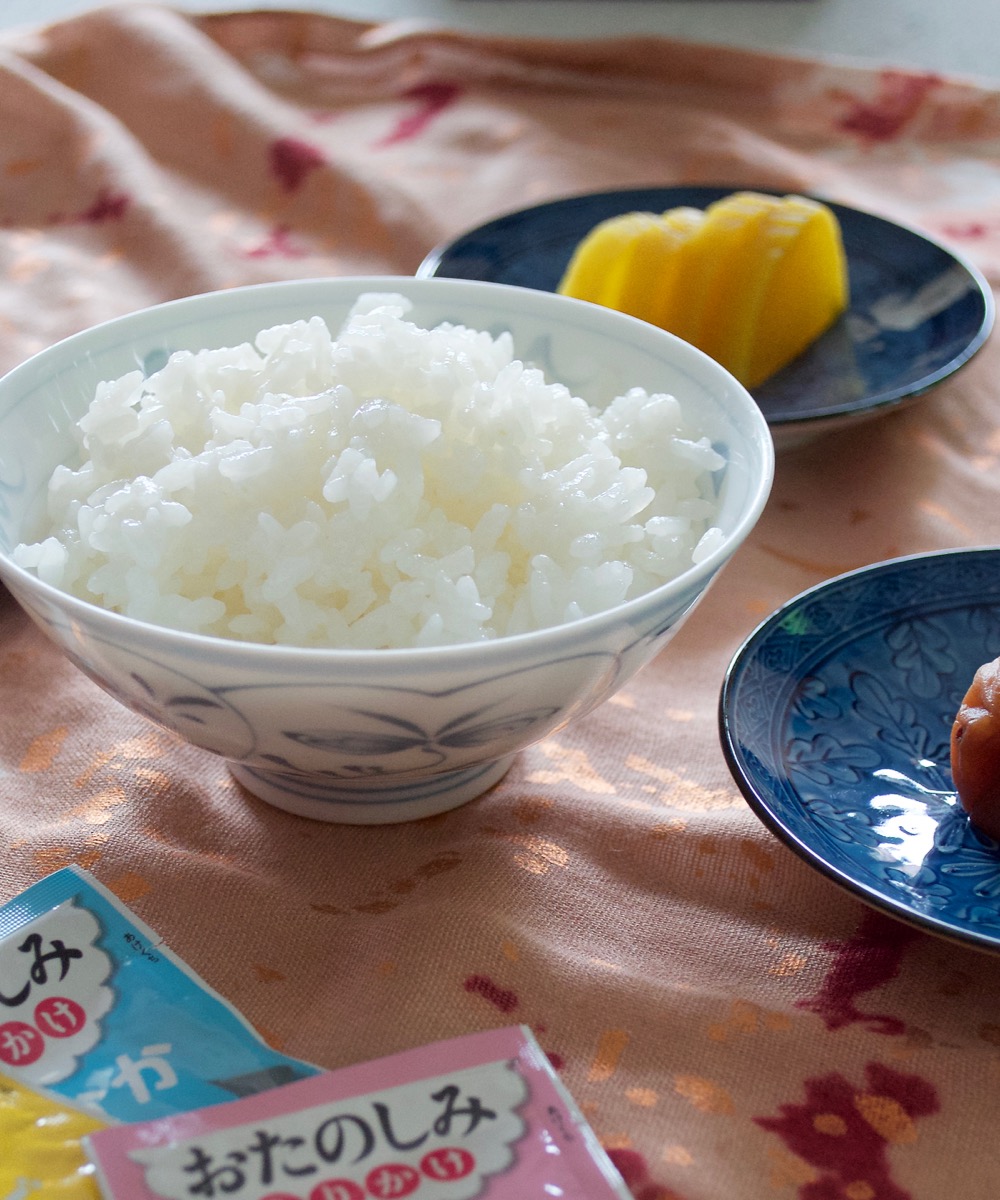
In Japanese culture, cooking rice (okome, お米) is almost an art. At home appliance stores in Japan, you will find so many different types of electric rice cookers on display.
About Rice in Japanese Cooking
Rice is one of the most important staple foods for Japanese people. People have a favourite brand of rice grain, and they strive to cook the best rice possible. Hence, most Japanese people have an electric rice cooker that will deliver consistent results.
Japanese rice is a short grain white rice that is fluffy and slightly sticky. Unlike long grain rice, including Basmati rice and jasmine rice, Japanese rice grains stick to each other when cooked. This is quite important because you can easily pick up a mouthful of rice with chopsticks.
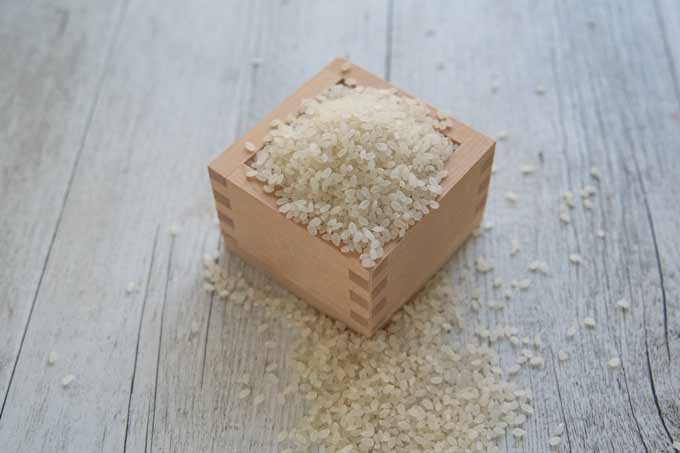
The brand of rice grain is also a critical factor. There are so many different brands from all over Japan as well as overseas and competition is fierce. Japanese farmers put a lot of effort into the pursuit of producing the best rice grain.
The high quality of rice however also means a high price. But many Japanese people say that they are happy to pay a lot for good rice, even if they have to buy cheaper side dishes to go with it.
Brands of Japanese Rice
If you are interested in trying Japanese rice, I would recommend the brand called Koshihikari (こしひかり or コシヒカリ). Koshihikari is one of the best brands of rice grain, noted for its sweet taste. It is the most popular brand in Japan.
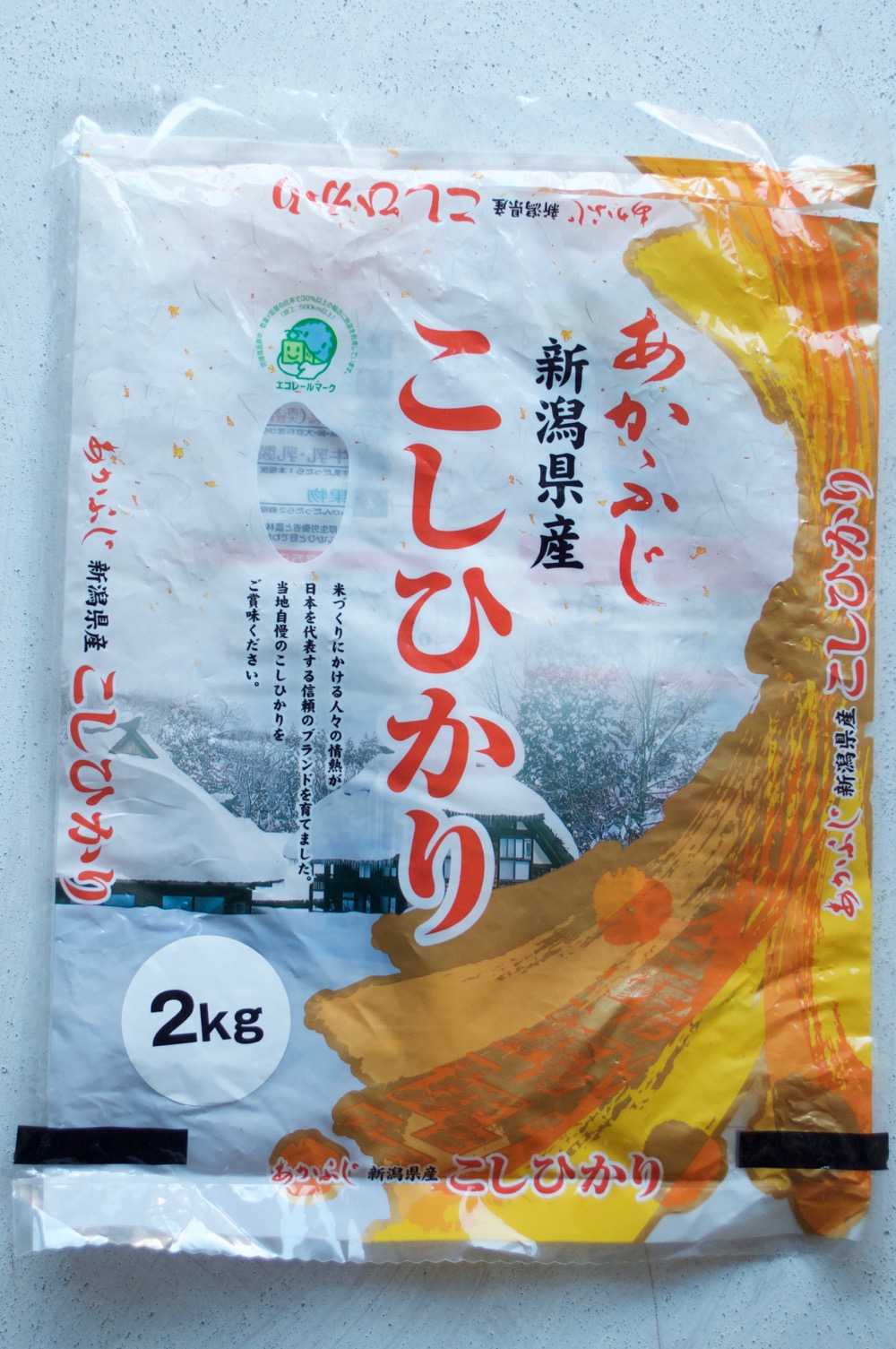
A bag of Koshihikari rice.
The Australian brand SunRice produces Koshihikari rice. You can even buy it at supermarkets these days.
From the original Koshihikari species, several new brands of rice were developed. They are Akitakomachi (あきたこまち), Hitomebore (ひとめぼれ) Hinohikari (ヒノヒカリ) and Milkyqueen (ミルキークイーン). Each of them has unique characteristics that are different from Koshihikari. You can buy some of these brands at Japanese grocery stores.
Another well-known rice brand that used to be neck and neck with Koshihikari is ‘Sasanishiki’ (ササニシキ or ささにしき). Unfortunately, Sasanishiki rice suffered from the extreme cold weather from 1980 to 1983 and the farmers had to reduce production of Sasanishiki rice significantly.
Sasanishiki (left photo below) is known to be best suited for sushi and sushi chefs in Japan are fond of this brand. As mentioned in my post Take Away Sushi Rolls, Sasanishiki rice is less glutenous than other species, so the sushi rice does not become sticky when sushi vinegar is mixed. You can still buy Sasanishiki rice at some Japanese/Asian grocery stores.
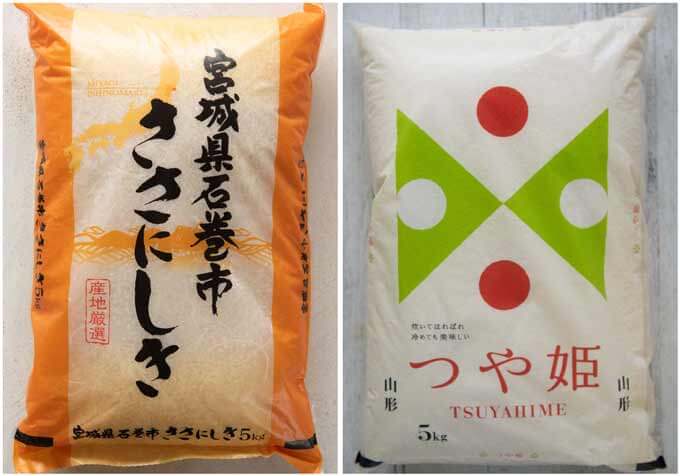
I sometimes buy the new rice brand called Tsuyahime (つや姫) at a Japanese grocery store (right photo above). The cooked rice is whiter and shinier than other brands. In addition to the appearance, it has a good balance of sweetness, umami, and stickiness. It was developed from the mutant of Koshihikari that was found 4 generations earlier.
The Japanese Way of Cooking Rice
Firstly, please do not cook Japanese rice in the same way as cooking pasta. I know that many Aussies simply boil cook their rice in a large amount of boiling water. It gave me a shock when I first learnt this. If you want to cook this way, please do not use the Japanese brand rice.
You can cook rice the Japanese way in a pot/saucepan on a cook top or in an electric rice cooker.
Cooking Rice in a saucepan on cook top
If you need to cook rice in a pot and want to make it just like the Japanese do, please follow the step-by-step instructions in the recipe. It might not look like as simple as you think, and you might wonder if you should be bothered making this much effort just for rice. But once you get used to it, it’s a simple process and you will never want to boil rice like pasta anymore.
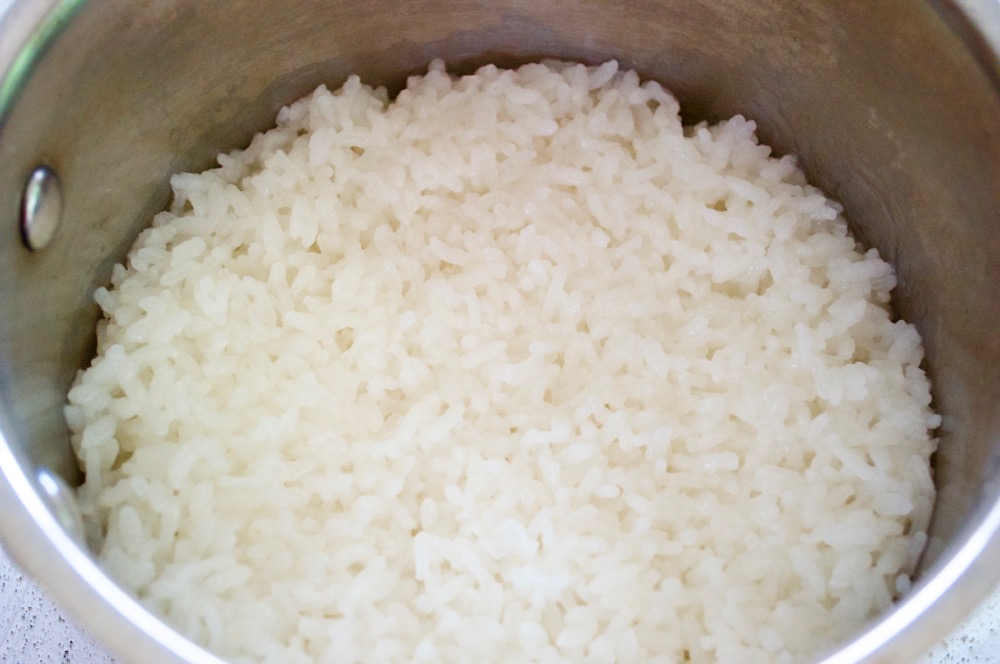
The key points are:
- Wash rice well – the powder around the rice makes the rice stickier.
- Soak the rice in water to let the rice grains absorb water – to cook rice evenly to the core of the grains.
- Rest after the heat is turned off – to make the rice fluffier.
- Mix the rice by turning the rice over from the bottom – to let the excess moisture evaporate.
Cooking Rice in a Rice Cooker
A rice cooker should come with a measuring cup. It is best to measure the rice with the cup provided.
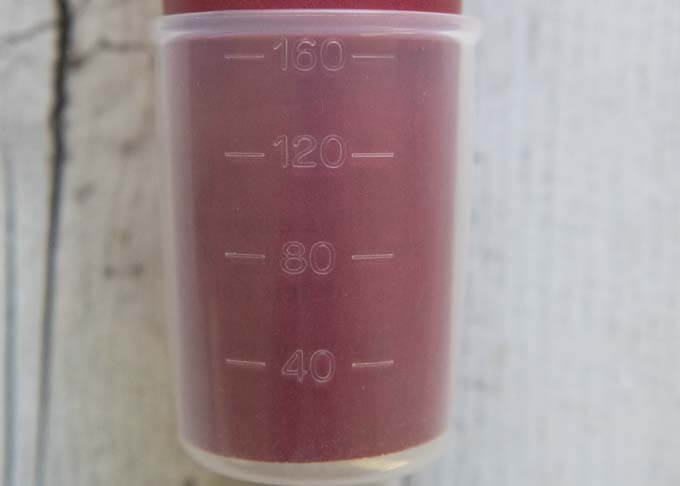
The capacity of the cup is 180ml / 6.1 fl oz, which is much smaller than the standard measuring cup. It is an odd volume as a metric unit, but it is not so odd if you think about the history of Japan. The next section explains the reason for it.
A rice cooker comes with an inner pot that goes inside the rice cooker. You will see the lines and numbers marked on the inside of the inner pot. These numbers indicate the water level required for the corresponding number of rice measuring cups. For example, if you are cooking 2 cups of rice, fill water to the line marked ‘2’, with the rice in it.
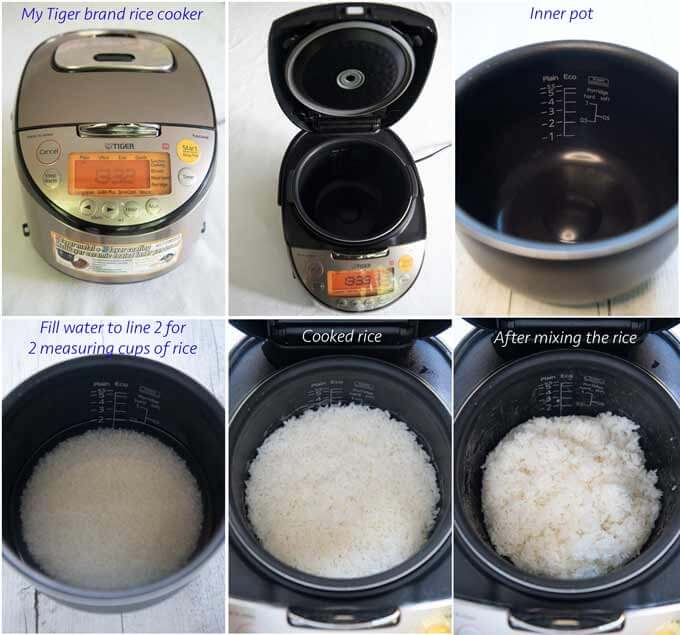
Even if you are cooking rice with a rice cooker, the 4 key points that I listed in the previous section applies. But if your rice cooker includes the water absorption time and the resting time in the cooking process, only the first and last key points apply.
Because you simply add water to the level indicated on the pot, there is no need for you to accurately measure the amount of water to put in the pot. So, I usually wash rice in the inner pot, add water to the required level, then turn the switch on.
Why is the rice measuring cup 180ml / 6.1 fl oz?
The capacity of 180ml comes from the old Japanese unit of measuring volume called ‘gou‘ (合). Until the Meiji Restoration, which ended the Edo period, Japanese people were using their own units to measure volume.
Gou is the second smallest unit. Instead of a plastic cup (as there was no such thing as plastic), people used a square wooden cup, which is almost equivalent to 180ml (180.39ml to be exact). The next level of unit is ‘shou‘ (升), which is 10 times of gou. 10 times of shou is ‘to‘ (斗, pronounce as /tɔ/ – the sound of toy without ‘i’), then 10 times of to is ‘koku‘ (石).
Traditional Japanese wooden measuring cup is called ‘masu’ (枡).
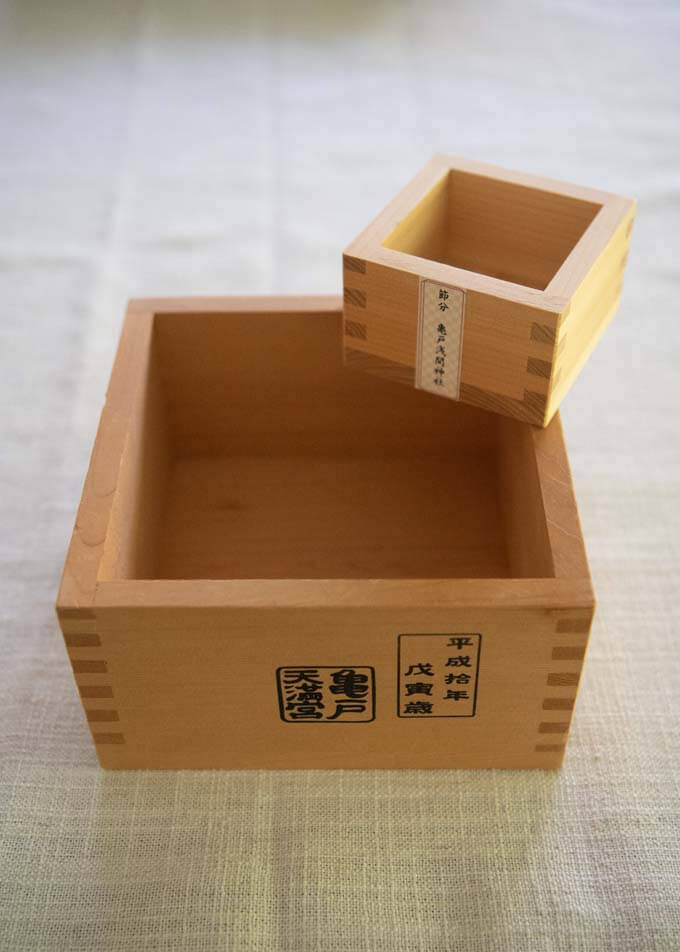
The volume of the small wooden measuring cup is 1 gou masu (about 180ml), the large cup is 1 shou masu (about1.8L).
In the Edo period, the farmers had to pay their tax to their feudal lords by way of supplying rice. So the prosperity of the feudal lords was expressed by the amount of rice, using the largest unit ‘koku‘ (石).
As part of the Meiji Restoration, the government replaced the old Japanese measurement units with the current metric system. But even now the old volume unit is still used for measuring rice.
Interestingly, the large bottle of Japanese sake is 1.8L / 3.8pt and people still call this bottle ‘isshōbin‘ (一升瓶), which means 1 shou bottle. Some Japanese restaurants serve cold sake in a skinny glass placed inside an ‘ichigou masu‘ (一合枡, 1 gou wooden measuring cup) – the small wooden cup in the photo above. Sake is associated with rice after all.
Japanese Etiquette when eating rice
If you would like to serve cooked rice (gohan, ご飯) the Japanese way, you will need a small bowl specifically made to serve rice called ochawan (お茶碗). As an alternative, you can serve the rice in a small ceramic bowl with a foot (i.e. base) so that you can hold the bowl without your fingers getting too hot.
You hold ochawan with one hand by placing the foot of the bowl on four fingers and the thumb on the rim, and hold chopsticks (箸, hash or お箸, ohashi) on the other hand (see the photo below). Yes, you do lift the bowl when eating rice. In fact, if you eat rice out of the bowl without lifting it from the table you will be considered to be lacking etiquette.
To eat the rice from the rice bowl, use your chopsticks and pinch a mouthful of rice, lift and move the chopsticks to your mouth. Placing the rim of the bowl to your mouth and sliding the rice into your mouth with chopsticks is considered to be bad manners.
In this recipe, I have included some typical condiments that Japanese people eat with rice to give it flavour. See the photo below – rice with umeboshi (梅干し, the pickled plum in the top right of the rice bowl), takuan (沢庵, pickled radish, yellow) and tarako furikake (ふりかけ, cod roe flavoured rice seasoning). You can just eat rice with these toppings without any other dishes.
Yumiko![]()
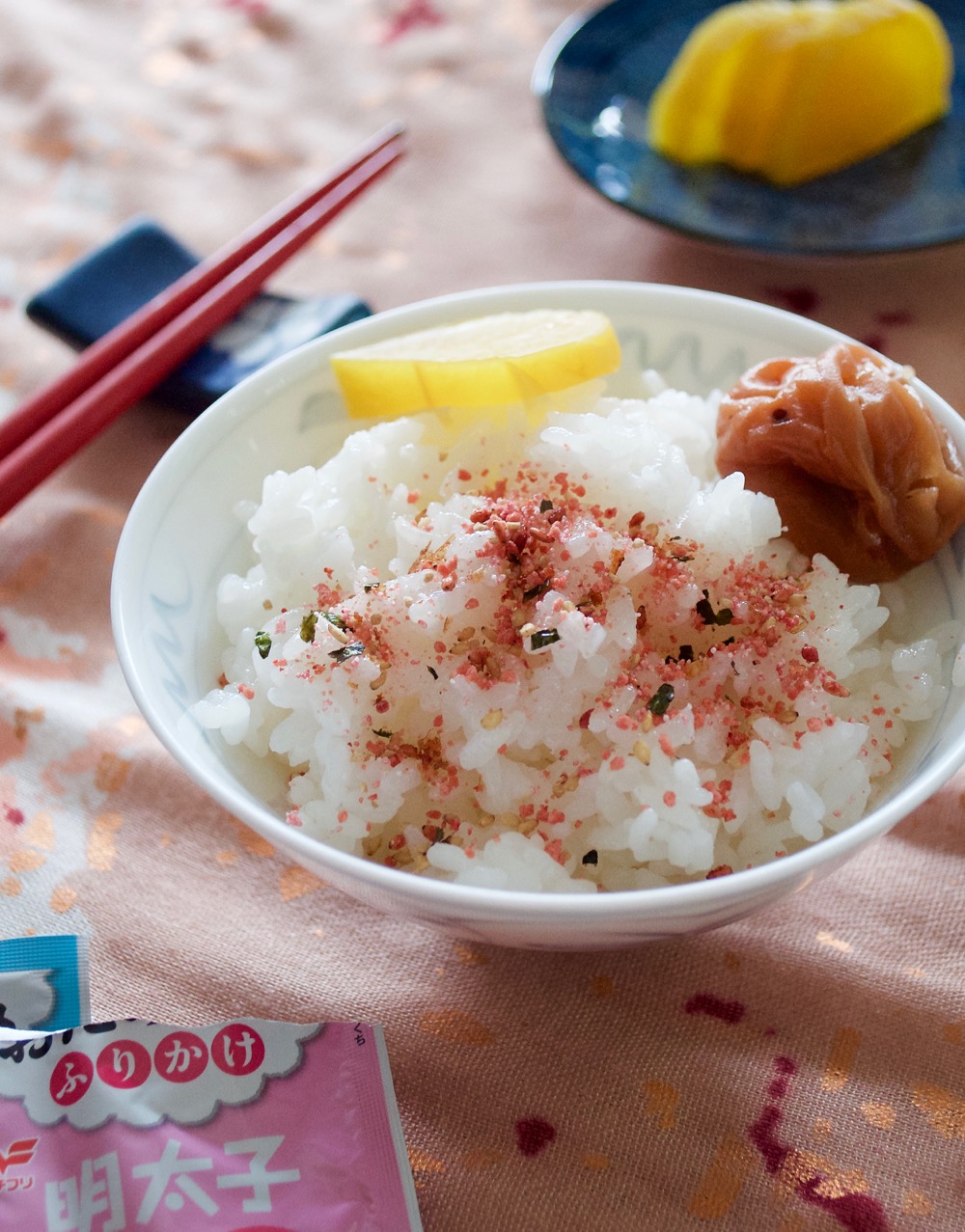
Originally published in August 2016. Added a recipe for cooking rice in a rice cooker, and improved photos and contents (no change to the original recipe).
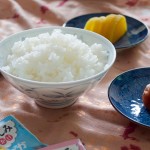
The Japanese way of cooking rice takes time, but the cooked rice is fluffier than it would be if you used the boiling method (it will not be soggy). Once you master it, you will not want to cook rice any other way!
The prep time does not include soaking time which varies depending on the season.
- 1 cup short grain or sushi rice (Note 1)
- 1 cup + 2-3 tbsp water (Note 2)
- Furikake (Cod roe flavoured rice seasoning)
- Umeboshi (Pickled plum)
- Takuan (Pickled white radish)
-
Accurately measure and place the rice in a large bowl. Add enough water (not in ingredients) to cover the rice and wash gently, then discard the water. Repeat the process 4-5 times until the water is almost clear.
-
Leave the rinsed rice in the bowl and add enough water (not in the ingredients) to cover the rice. Leave the rice to soak for 30 minutes (summertime) to 1 hour (wintertime). (Note 3)
-
Using a sieve, drain the rice and remove as much water as possible.
-
Place the rice in a saucepan with a heavy bottom and add water (per the ingredients list). Cook over medium heat with a lid on.
-
When the water starts boiling and bubbles come out of the pot, reduce the heat to low. Cook for 12-15 minutes until there is no water at the bottom of the pot or you don’t hear a bubbling sound from inside the pot. Do not open the lid while cooking.
-
Turn the heat off and leave for at least 10 minutes with the lid on. Then mix the rice using a rice spatula (if you have one). This is to remove excess moisture within the cooked rice grains. Also the rice does not to mould into the shape of the pot at the bottom.
-
Furikake (ふりかけ) is a dried Japanese seasoning that is sprinkled on top of cooked rice. Ingredients include a combination of dried fish flakes, dried egg, dried cod eggs, bonito flakes, sesame seeds, chopped seaweed and other flavourings.
-
Umeboshi (梅干し) is a salty and sour pickled plum. There are brown umeboshi (natural colour) and red umeboshi (dyed using purple perilla). Large umeboshi are about 2-3 cm (¾-1¼") diameter and have a very soft texture, while tiny umeboshi are normally crunchy. The seed inside an umeboshi is very hard and you should not eat it as you might break your teeth.
-
Takuan (沢庵) is one of the many pickled vegetables that Japanese people love. Unlike some of the western-style pickling, Japanese people do not use oil to pickle vegetables. They typically use any combination of salt, soy sauce and vinegar.
1. Short grain or sushi rice are the closest types of rice to Japanese rice. You could use medium grain, but long grain or any other rice grains are not suitable. I buy Japanese short grain rice called ‘Koshihikari’ (こしひかりorコシヒカリ). I like it because the cooked rice is fluffier and shinier than other types. In Australia, you can buy Koshihikari at most Asian grocery shops and definitely at Japanese grocery shops.
2. The amount of water required depends on your preference for the cooked rice (al dente vs soft), age of the rice grain (new rice needs less water), and the pot you use (more steam evaporates with a wider pot). You will need to experiment and work out the exact amount that suits you.
3. This is a traditional way of cooking fluffy rice. You will see that each grain becomes white after absorbing the water. If you don’t have time to soak the rice in the water, you can cook it straight away. In this case you might need to increase the amount of water slightly when cooking the rice.
4. If you are using the rice for sushi, placer a pice of konbu on top of the water, then cook rice. The rice will absorb umami from the konbu.
5. Leftover rice can be kept in the fridge for a few days or in the freezer. Use the microwave to thaw and re-heat.
6. Because of the strong flavour of these condiments, Japanese people sometimes eat rice with just these when they are in a hurry or just to fill themselves up without going through the hassle of cooking a meal.
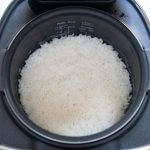
A rice cooker should come with a measuring cup. The capacity of the cup is 180ml, which is much smaller than the standard measuring cup. It is best to measure the rice with the cup provided.
The time taken to cook rice varies depending on the cooking option selected. I have indicated the longest cooking time (includes water absorption and resting time) on my Tiger brand rice cooker.
- 2 rice cooker cups of rice (180ml x 2 / 6.1 fl oz x 2)
- Water
-
Remove the inner pot from the rice cooker and put the rice in the pot.
-
Add enough water to cover the rice and wash it gently, then discard the water. Repeat the process 4-5 times until the water is almost clear.
-
Add water to the line marked ‘2’ on the side of the inner pot. Shake the pot gently and level the surface of the rice. (note 7)
-
Wipe off the water around the outer surface of the inner pot and place it in the rice cooker.
-
Leave it for 15 minutes to let the rice absorb water (note 2).
-
Turn the switch on.
-
When the rice cooker completes cooking, let the rice rest for 10-15 minutes with the lid on (note 3).
-
Using a rice spatula (note 4), mix the rice by turning the rice over from the bottom, then mix (note 5). This process lets the excess steam evaporate, preventing the rice from getting too sticky.
1. Measure the rice using the cup that came with the rice cooker. If you lose the cup, use a measuring cup and measure 360ml / 12.2 fl oz of rice.
2. This step is required only if your rice cooker is a very simple rice cooker with no menu options, or you are using the Quick Cook option on more advanced rice cookers. Advanced rice cookers that take 50-60 minutes to finish cooking (standard cooking option) includes the water absorption time.
3. This step is required only if your rice cooker is a very simple rice cooker with no menu options, or you are using the Quick Cook option on more advanced rice cookers. This is called the steaming process and it allows the excess moisture in the pot to evaporate. Advanced rice cookers that take 50-60 minutes to finish cooking includes the steaming process.
4. A plastic rice spatula usually comes with the rice cooker. But if don't have one, use a plastic/wooden round spatula. Never use a metal spoon if your inner pot has a non-stick coating.
5. It is easier if you make a cross on the surface of the rice and turn ¼ of the rice at a time to turn over and mix.
6. When the rice is cooked, the rice cooker should switch to 'warm' mode to keep the cooked rice warm. It is recommended not to keep it warm for more than 5-6 hours to maintain the quality of the cooked rice.
You can leave it warm for 12-24 hours, but the rice becomes dry. The flavour also degrades. It is better to take the rice out of the rice cooker and keep it in the fridge or freeze it.
7. If you are using the rice for sushi, placer a pice of konbu on top of the water. The rice will absorb umami from the konbu.
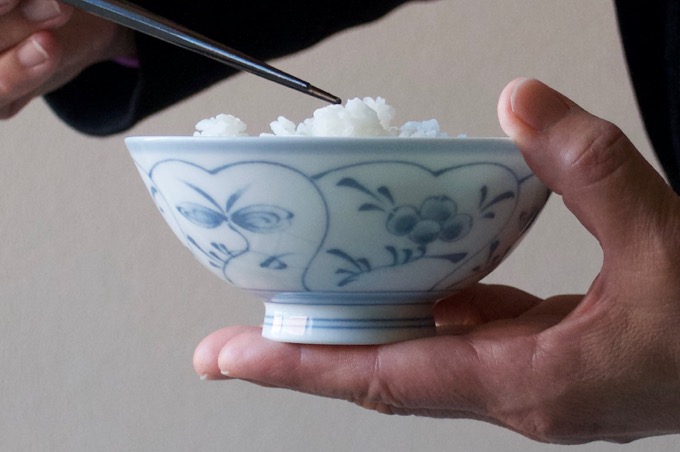
I’ve never been a huge fan of rice, mostly because of the texture and feel of it in my mouth, but man! I haven’t eaten better in a while! Your instructions were very clear, and I very much enjoyed this rice! Used it to make some rice balls, very good!! Thank you so much <3
Hi Elias, that’s great. You are converted!
I followed your instructions using a LondonWok rice cooker and the rice came out a gloopy soaking wet mess. I cooked 2 cups of Toyama Koshihikari Rice and followed the instructions on my rice cooker. I used my rice cooker cup which goes up to 160ml (I did 2 cups) and then I added water up to the 2 water line.
It is far too much water, it seems that my rice cooker can only cook long grain rice without issues. I do not have any special menus besides “cook” and “warm” such a shame, as the rice is very expensive in my country.
Hi Scarlet, I am sorry Koshihikari rice didn’t work with your rice cooker. I don’t know what brand of rice cooker you have, but a 160ml cup is not a standard Japanese-style measuring of the rice. You could experiment the quantity of water by using the measuring cup and cheaper short grain/medium grain rice. Instead of filling water to the marked line, add water using the cup and work out the right amount of water.
I hope you cae figure out the right amount of water with Koshihikari. Otherwise, use a thick bottomed pot per the recipe.
Hi ,yumiko,I mostly cook short grain rice 70 percent and about thirty percent red lentils cooked together salt added,in India called khechdi.After finished cooking add some butter on top and let it dissolve into the rice.Very very tasty.
Hi Navnit, thanks for this. I looked at images on the internet. the colour is amazing. I should try it.
Hi Yumiko I followed this recipe for stove top cooking but it was a big fail – way too much water and it was a big pot of glug. The rice to water ratio seemed to be 1:1.25 for pre-soaked rice but this is really different to what I’ve read elsewhere where it’s suggested to be 1:1 or 1:1.1 for soaked rice.
Should the soaking water really not be part of the cooking? I think if I’d soaked it in the recommended amount and then cooked in the same water Like a rice cooker does) it might have worked better and avoided the glug
Hi Peter, the rice:water ratio is not 1:1.25. For 250ml of rice, the recipe says water is 280-295ml (1 cup = 250ml and 2-3 tbsp = 30-45ml), which is 1.12-1.18. If you used the ratio of 1.25, i.e. 315.5ml, the cooked rice would be soggy.
I live in Hawaii! Which rice should I buy? I would really want best quality rice! Thank you!
Hi Clayton, I don’t live in Hawaii so I am not sure what brands of Japanese rice are available. A choice of rice also depends on your palate. I am a fan of made-in-Japan rice, and I tried all of the sample photos that you find in the section JAPANESE RICE in my post, PANTRY ESSENTIALS FOR JAPANESE HOME COOKING – PART 2. Among those, I like Yumepirika, which gained the 2nd place in one of the best-rice-ranking in Japan. The 1st place was Koshihikari rice from Uonuma, which I currently have. I have to say that Uonuma Koshihikari is the best so far – grains are so shiny when cooked, slightly sweet and so fluffy.
I presume there are many Japanese grocery stores in Hawaii. I am sure some stores sell Uonuma Koshihikari. If not, go online.
From Toronto, Ontario, Canada:
I like the taste of rice but not that it falls apart like grains of sand. I’ve bought so called sticky rice and ended up with the same result.
Today, I followed this recipe for Japanese cooked rice. All I can say is … I WILL NEVER COOK RICE ANY OTHER WAY AGAIN !!!
Yes, it takes a little more time, but it sure is worth it.
A question: If the rice is rinsed, soaked and drained the rice the night before, would it turn out the same or almost the same? I will try it next time.
Hi Ingrid, I am glad that you found the right cooking method for the rice. Yes, you can get the rice ready the night before. I often do that.
I’ve been to Toronto. I enjoyed the stay.
Hi Yumiko! I was so happy to find your site and have let my eldest son know all about it too. He cooked us a meal last weekend using one of your recipes (katsu curry) and it was delicious! I was just wondering where you picked up your Tiger rice cooker and which model it is? I had looked for one some years ago now, but they were never made for Australian power outlets, but now I see there are quite a few around. Because of the price tag, I am a bit careful of which one I choose!
Hi Paula, my son and his partner bought it for me from an Asian store in Burwood Plaza. The model no. of my rice cooker is JKT-S10A. It’s probably on high-end of this range as I wanted the thick inner bowl. It came with multi functions including steaming and slow cooking, although I have not used these functions yet.
If you don’t cook rice often and are happy with just fluffy cooked rice, you don’t need to buy an expensive ones. Other Japanese brands are good too.
hi Yumiko – the rice I have from my local Asian market (at least, the kind that didn’t come in 20 lb. bags!) starts out quite a bit more white/opaque than the rice in your photos. The brand is Shirakiku “extra fancy sweet rice.” Will it cook up the same way? I’ve actually used it before for home made sushi, but have not tried making it your way (though I will next time!).
Hi Jill, it is quite possible that your Shirakiku rice is glutinous rice (also called sticky rice, and mochigome in Japanese). The name ‘sweet rice’ also implies that.
See the middle photo in this article about glutinous rice. Does your grain look like this? The grain of glutinous rice is white rather than semi-transparent.
The cooked rice would be stickier than normal short grain rice. You will need less water to cook sticky rice than normal rice. In the article mentioned above, it mentions Shimeji Gohan with a hyperlink. At the end of the Shimeji Gohan post, it tells you the amount of water you need to cook sticky rice.
It is OK to eat sticky rice but it’s not best for sushi rice.
Yes indeed, that is exactly what my rice looks like! And oh dear! I made some tonight and it came out a big mushy glob! (too much water obviously) Is there a remedy for this type of rice, I hate to throw it out!
Hi Jill, oh dear indeed. The only thing I could think of to make use of the soggy/mushy rice would be to convert it to zōsui. My recipe uses normal cooked rice but you can make zōsui with mushy rice which makes the dish much closer to congee.
I have been fascinated with Japanese culture since traveling to Japan for work years ago. I even studied the Japanese language for a while, unsuccessfully. I thoroughly enjoyed your article and learned much about your culture and your family. I will try and break my habit of the “Chinese” style of cooking my rice and try this method.
I have enjoyed and learned so much from your daughter Nagi and now I understand how she came to love cooking. Thank you both.
Thanks! Chinese rice is less sticky than the Japanese rice and it’s meant to be cooked in such way that each grain should not stick like the Japanese cooked rice. Depending on the dish you accompany with, you probably want to use different rice and cooke it differently. If you want the rice to be stack, then I strongly recommend using my recipe.
Great to read the history attached to Japanese rice making. I purchased a rice cooker a few years ago when visiting Tokyo. Thought I was doing a good job but I see I can improve with your detailed instructions.
Love the way you write. You and Nagi inspire me constantly 🙂
Hi vo vo, nothing is more satisfying than well cooked rice!